Analysis of Leadership, Management, and Operation at Marks and Spencer
VerifiedAdded on 2021/02/21
|15
|4844
|58
Report
AI Summary
This report provides an in-depth analysis of leadership and management practices within Marks and Spencer. It begins by differentiating between the roles of leaders and managers, outlining their respective characteristics and functions within the organization. The report then explores various leadership styles, including democratic, autocratic, and the application of hard and soft management skills. Furthermore, it delves into the importance of operational management, examining key approaches and their value to the business. The core of the analysis focuses on different leadership theories and models, such as situational, system, and contingency leadership theories, evaluating their strengths and weaknesses within the context of Marks and Spencer. Finally, the report considers factors within the business environment that influence management and leadership, concluding with recommendations for future improvements.
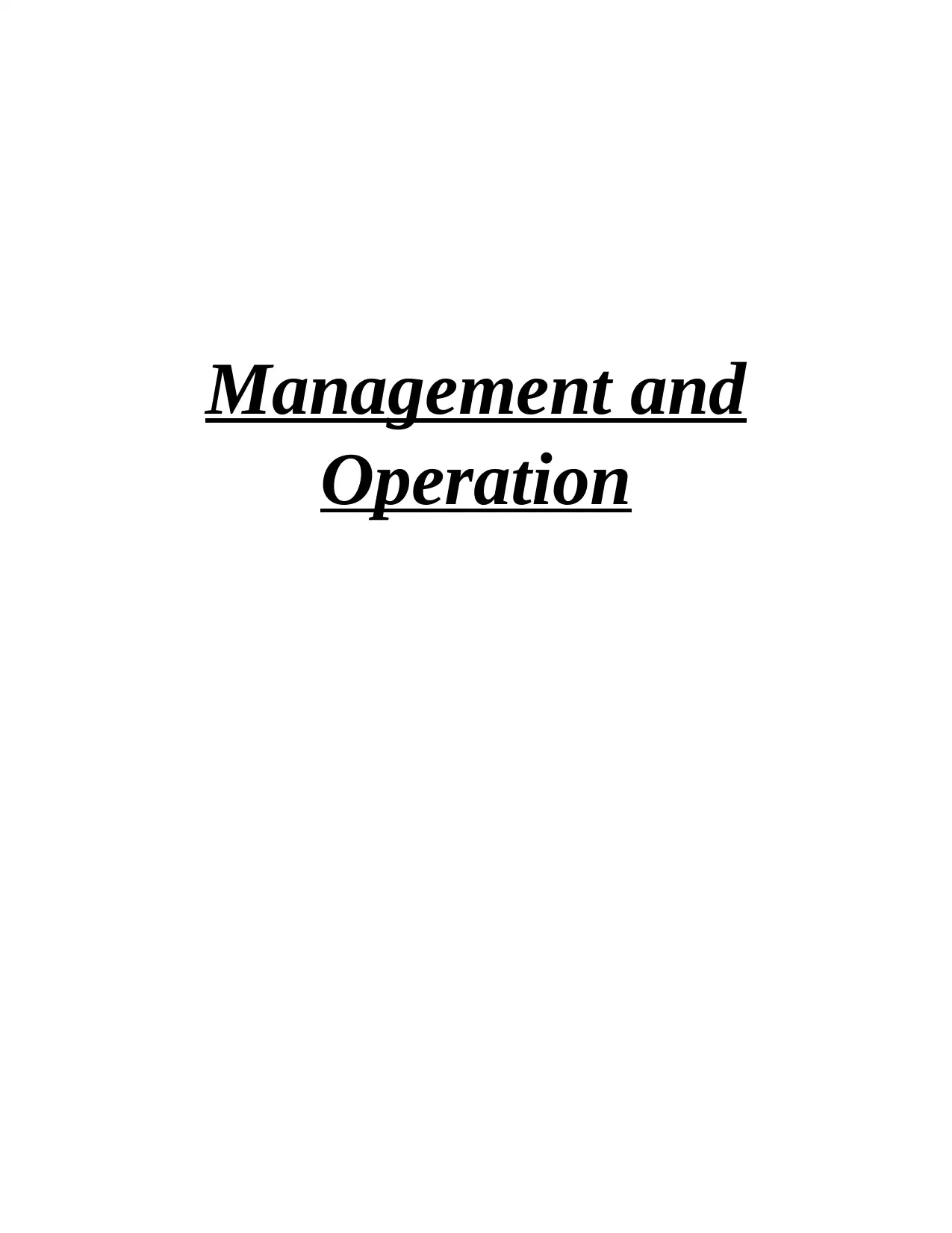
Management and
Operation
Operation
Paraphrase This Document
Need a fresh take? Get an instant paraphrase of this document with our AI Paraphraser
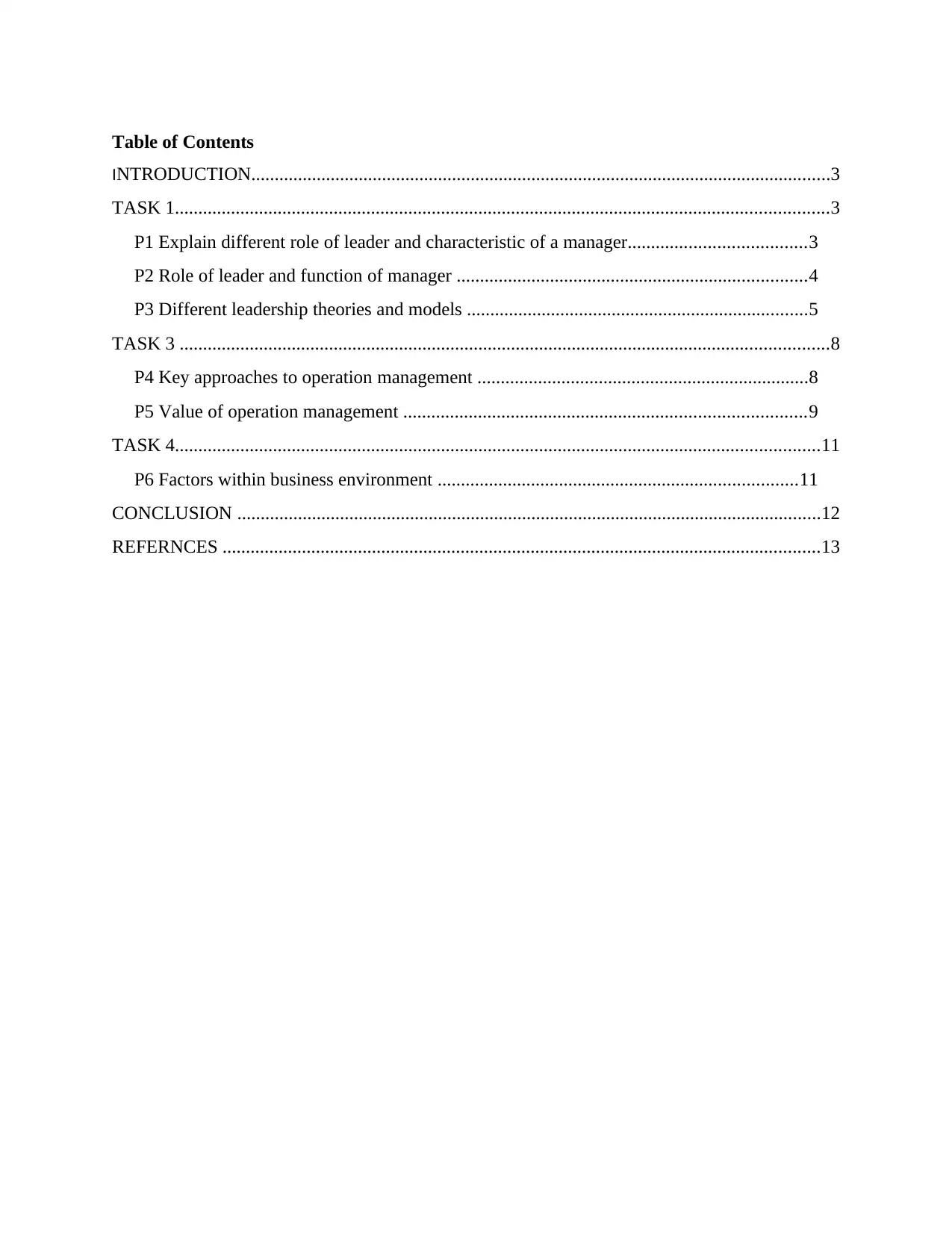
Table of Contents
INTRODUCTION............................................................................................................................3
TASK 1............................................................................................................................................3
P1 Explain different role of leader and characteristic of a manager......................................3
P2 Role of leader and function of manager ...........................................................................4
P3 Different leadership theories and models .........................................................................5
TASK 3 ...........................................................................................................................................8
P4 Key approaches to operation management .......................................................................8
P5 Value of operation management ......................................................................................9
TASK 4..........................................................................................................................................11
P6 Factors within business environment .............................................................................11
CONCLUSION .............................................................................................................................12
REFERNCES ................................................................................................................................13
INTRODUCTION............................................................................................................................3
TASK 1............................................................................................................................................3
P1 Explain different role of leader and characteristic of a manager......................................3
P2 Role of leader and function of manager ...........................................................................4
P3 Different leadership theories and models .........................................................................5
TASK 3 ...........................................................................................................................................8
P4 Key approaches to operation management .......................................................................8
P5 Value of operation management ......................................................................................9
TASK 4..........................................................................................................................................11
P6 Factors within business environment .............................................................................11
CONCLUSION .............................................................................................................................12
REFERNCES ................................................................................................................................13
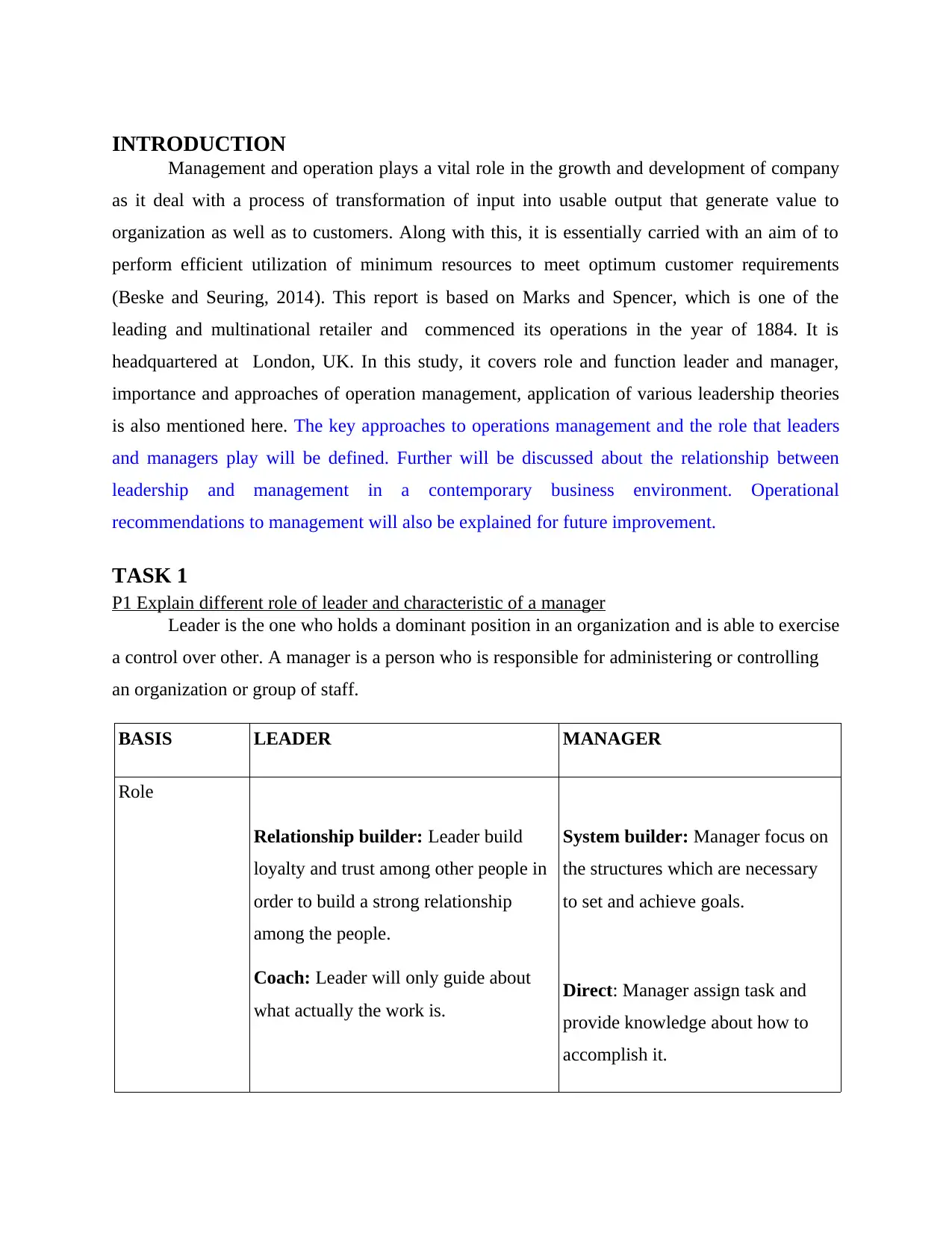
INTRODUCTION
Management and operation plays a vital role in the growth and development of company
as it deal with a process of transformation of input into usable output that generate value to
organization as well as to customers. Along with this, it is essentially carried with an aim of to
perform efficient utilization of minimum resources to meet optimum customer requirements
(Beske and Seuring, 2014). This report is based on Marks and Spencer, which is one of the
leading and multinational retailer and commenced its operations in the year of 1884. It is
headquartered at London, UK. In this study, it covers role and function leader and manager,
importance and approaches of operation management, application of various leadership theories
is also mentioned here. The key approaches to operations management and the role that leaders
and managers play will be defined. Further will be discussed about the relationship between
leadership and management in a contemporary business environment. Operational
recommendations to management will also be explained for future improvement.
TASK 1
P1 Explain different role of leader and characteristic of a manager
Leader is the one who holds a dominant position in an organization and is able to exercise
a control over other. A manager is a person who is responsible for administering or controlling
an organization or group of staff.
BASIS LEADER MANAGER
Role
Relationship builder: Leader build
loyalty and trust among other people in
order to build a strong relationship
among the people.
Coach: Leader will only guide about
what actually the work is.
System builder: Manager focus on
the structures which are necessary
to set and achieve goals.
Direct: Manager assign task and
provide knowledge about how to
accomplish it.
Management and operation plays a vital role in the growth and development of company
as it deal with a process of transformation of input into usable output that generate value to
organization as well as to customers. Along with this, it is essentially carried with an aim of to
perform efficient utilization of minimum resources to meet optimum customer requirements
(Beske and Seuring, 2014). This report is based on Marks and Spencer, which is one of the
leading and multinational retailer and commenced its operations in the year of 1884. It is
headquartered at London, UK. In this study, it covers role and function leader and manager,
importance and approaches of operation management, application of various leadership theories
is also mentioned here. The key approaches to operations management and the role that leaders
and managers play will be defined. Further will be discussed about the relationship between
leadership and management in a contemporary business environment. Operational
recommendations to management will also be explained for future improvement.
TASK 1
P1 Explain different role of leader and characteristic of a manager
Leader is the one who holds a dominant position in an organization and is able to exercise
a control over other. A manager is a person who is responsible for administering or controlling
an organization or group of staff.
BASIS LEADER MANAGER
Role
Relationship builder: Leader build
loyalty and trust among other people in
order to build a strong relationship
among the people.
Coach: Leader will only guide about
what actually the work is.
System builder: Manager focus on
the structures which are necessary
to set and achieve goals.
Direct: Manager assign task and
provide knowledge about how to
accomplish it.
⊘ This is a preview!⊘
Do you want full access?
Subscribe today to unlock all pages.

Trusted by 1+ million students worldwide
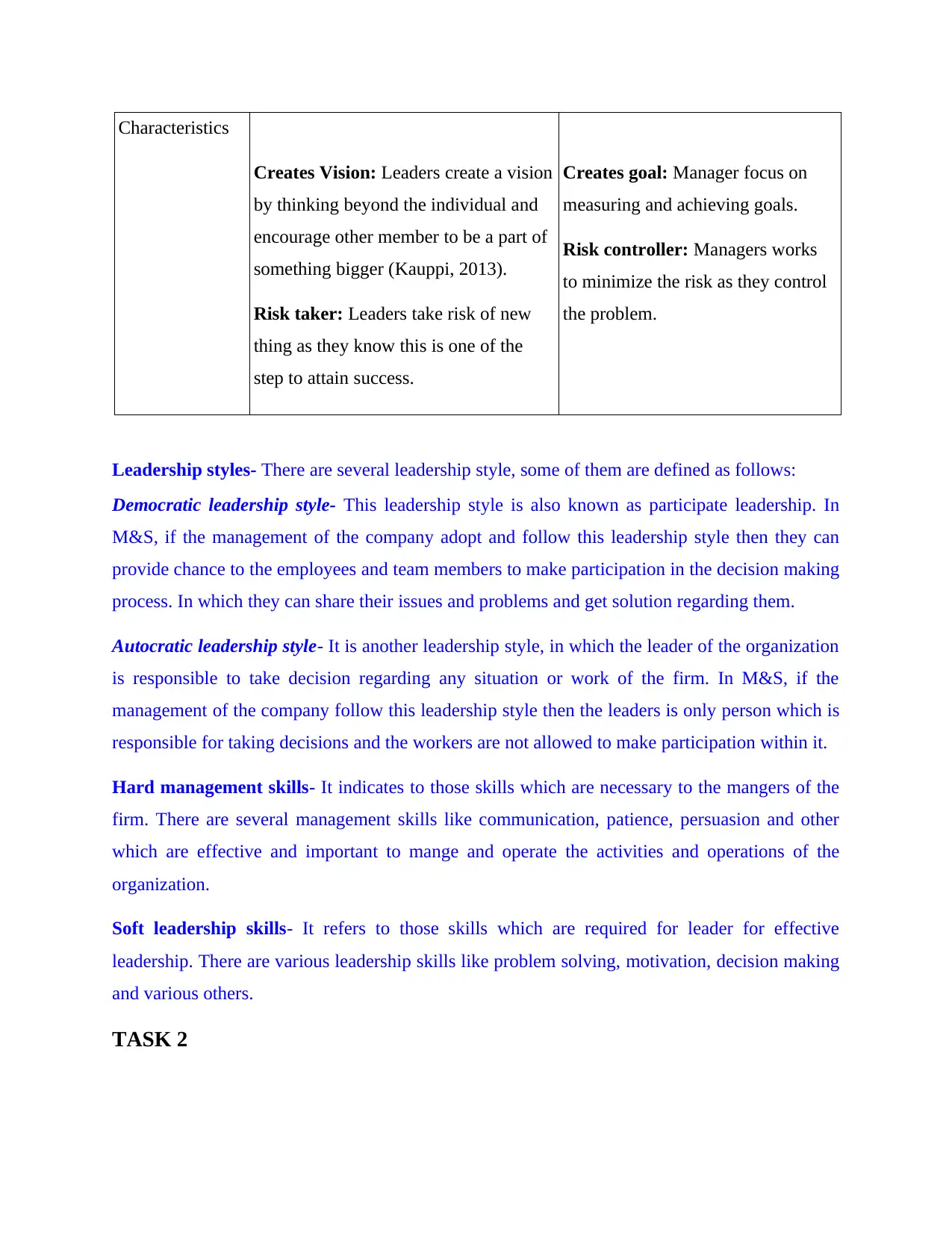
Characteristics
Creates Vision: Leaders create a vision
by thinking beyond the individual and
encourage other member to be a part of
something bigger (Kauppi, 2013).
Risk taker: Leaders take risk of new
thing as they know this is one of the
step to attain success.
Creates goal: Manager focus on
measuring and achieving goals.
Risk controller: Managers works
to minimize the risk as they control
the problem.
Leadership styles- There are several leadership style, some of them are defined as follows:
Democratic leadership style- This leadership style is also known as participate leadership. In
M&S, if the management of the company adopt and follow this leadership style then they can
provide chance to the employees and team members to make participation in the decision making
process. In which they can share their issues and problems and get solution regarding them.
Autocratic leadership style- It is another leadership style, in which the leader of the organization
is responsible to take decision regarding any situation or work of the firm. In M&S, if the
management of the company follow this leadership style then the leaders is only person which is
responsible for taking decisions and the workers are not allowed to make participation within it.
Hard management skills- It indicates to those skills which are necessary to the mangers of the
firm. There are several management skills like communication, patience, persuasion and other
which are effective and important to mange and operate the activities and operations of the
organization.
Soft leadership skills- It refers to those skills which are required for leader for effective
leadership. There are various leadership skills like problem solving, motivation, decision making
and various others.
TASK 2
Creates Vision: Leaders create a vision
by thinking beyond the individual and
encourage other member to be a part of
something bigger (Kauppi, 2013).
Risk taker: Leaders take risk of new
thing as they know this is one of the
step to attain success.
Creates goal: Manager focus on
measuring and achieving goals.
Risk controller: Managers works
to minimize the risk as they control
the problem.
Leadership styles- There are several leadership style, some of them are defined as follows:
Democratic leadership style- This leadership style is also known as participate leadership. In
M&S, if the management of the company adopt and follow this leadership style then they can
provide chance to the employees and team members to make participation in the decision making
process. In which they can share their issues and problems and get solution regarding them.
Autocratic leadership style- It is another leadership style, in which the leader of the organization
is responsible to take decision regarding any situation or work of the firm. In M&S, if the
management of the company follow this leadership style then the leaders is only person which is
responsible for taking decisions and the workers are not allowed to make participation within it.
Hard management skills- It indicates to those skills which are necessary to the mangers of the
firm. There are several management skills like communication, patience, persuasion and other
which are effective and important to mange and operate the activities and operations of the
organization.
Soft leadership skills- It refers to those skills which are required for leader for effective
leadership. There are various leadership skills like problem solving, motivation, decision making
and various others.
TASK 2
Paraphrase This Document
Need a fresh take? Get an instant paraphrase of this document with our AI Paraphraser
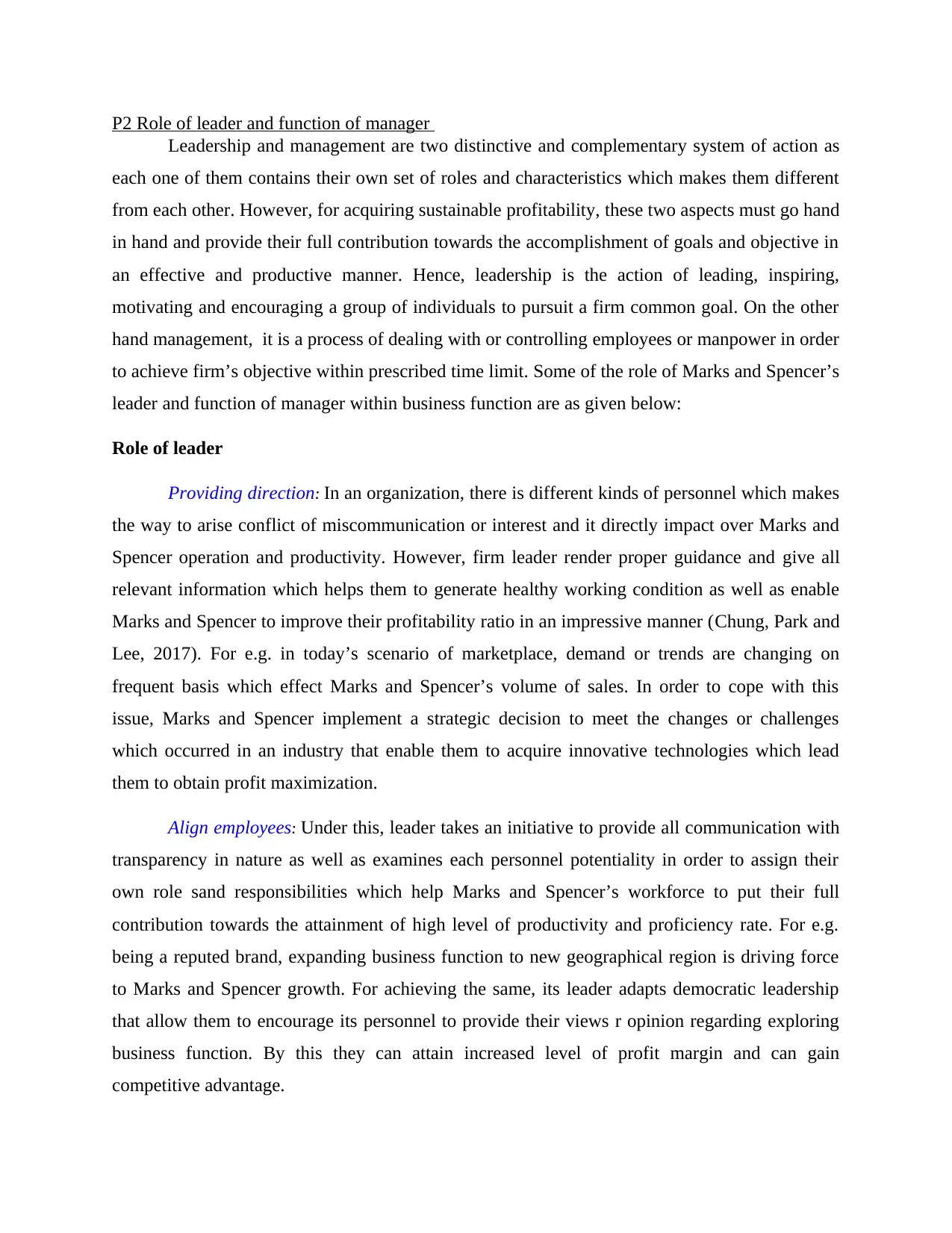
P2 Role of leader and function of manager
Leadership and management are two distinctive and complementary system of action as
each one of them contains their own set of roles and characteristics which makes them different
from each other. However, for acquiring sustainable profitability, these two aspects must go hand
in hand and provide their full contribution towards the accomplishment of goals and objective in
an effective and productive manner. Hence, leadership is the action of leading, inspiring,
motivating and encouraging a group of individuals to pursuit a firm common goal. On the other
hand management, it is a process of dealing with or controlling employees or manpower in order
to achieve firm’s objective within prescribed time limit. Some of the role of Marks and Spencer’s
leader and function of manager within business function are as given below:
Role of leader
Providing direction: In an organization, there is different kinds of personnel which makes
the way to arise conflict of miscommunication or interest and it directly impact over Marks and
Spencer operation and productivity. However, firm leader render proper guidance and give all
relevant information which helps them to generate healthy working condition as well as enable
Marks and Spencer to improve their profitability ratio in an impressive manner (Chung, Park and
Lee, 2017). For e.g. in today’s scenario of marketplace, demand or trends are changing on
frequent basis which effect Marks and Spencer’s volume of sales. In order to cope with this
issue, Marks and Spencer implement a strategic decision to meet the changes or challenges
which occurred in an industry that enable them to acquire innovative technologies which lead
them to obtain profit maximization.
Align employees: Under this, leader takes an initiative to provide all communication with
transparency in nature as well as examines each personnel potentiality in order to assign their
own role sand responsibilities which help Marks and Spencer’s workforce to put their full
contribution towards the attainment of high level of productivity and proficiency rate. For e.g.
being a reputed brand, expanding business function to new geographical region is driving force
to Marks and Spencer growth. For achieving the same, its leader adapts democratic leadership
that allow them to encourage its personnel to provide their views r opinion regarding exploring
business function. By this they can attain increased level of profit margin and can gain
competitive advantage.
Leadership and management are two distinctive and complementary system of action as
each one of them contains their own set of roles and characteristics which makes them different
from each other. However, for acquiring sustainable profitability, these two aspects must go hand
in hand and provide their full contribution towards the accomplishment of goals and objective in
an effective and productive manner. Hence, leadership is the action of leading, inspiring,
motivating and encouraging a group of individuals to pursuit a firm common goal. On the other
hand management, it is a process of dealing with or controlling employees or manpower in order
to achieve firm’s objective within prescribed time limit. Some of the role of Marks and Spencer’s
leader and function of manager within business function are as given below:
Role of leader
Providing direction: In an organization, there is different kinds of personnel which makes
the way to arise conflict of miscommunication or interest and it directly impact over Marks and
Spencer operation and productivity. However, firm leader render proper guidance and give all
relevant information which helps them to generate healthy working condition as well as enable
Marks and Spencer to improve their profitability ratio in an impressive manner (Chung, Park and
Lee, 2017). For e.g. in today’s scenario of marketplace, demand or trends are changing on
frequent basis which effect Marks and Spencer’s volume of sales. In order to cope with this
issue, Marks and Spencer implement a strategic decision to meet the changes or challenges
which occurred in an industry that enable them to acquire innovative technologies which lead
them to obtain profit maximization.
Align employees: Under this, leader takes an initiative to provide all communication with
transparency in nature as well as examines each personnel potentiality in order to assign their
own role sand responsibilities which help Marks and Spencer’s workforce to put their full
contribution towards the attainment of high level of productivity and proficiency rate. For e.g.
being a reputed brand, expanding business function to new geographical region is driving force
to Marks and Spencer growth. For achieving the same, its leader adapts democratic leadership
that allow them to encourage its personnel to provide their views r opinion regarding exploring
business function. By this they can attain increased level of profit margin and can gain
competitive advantage.
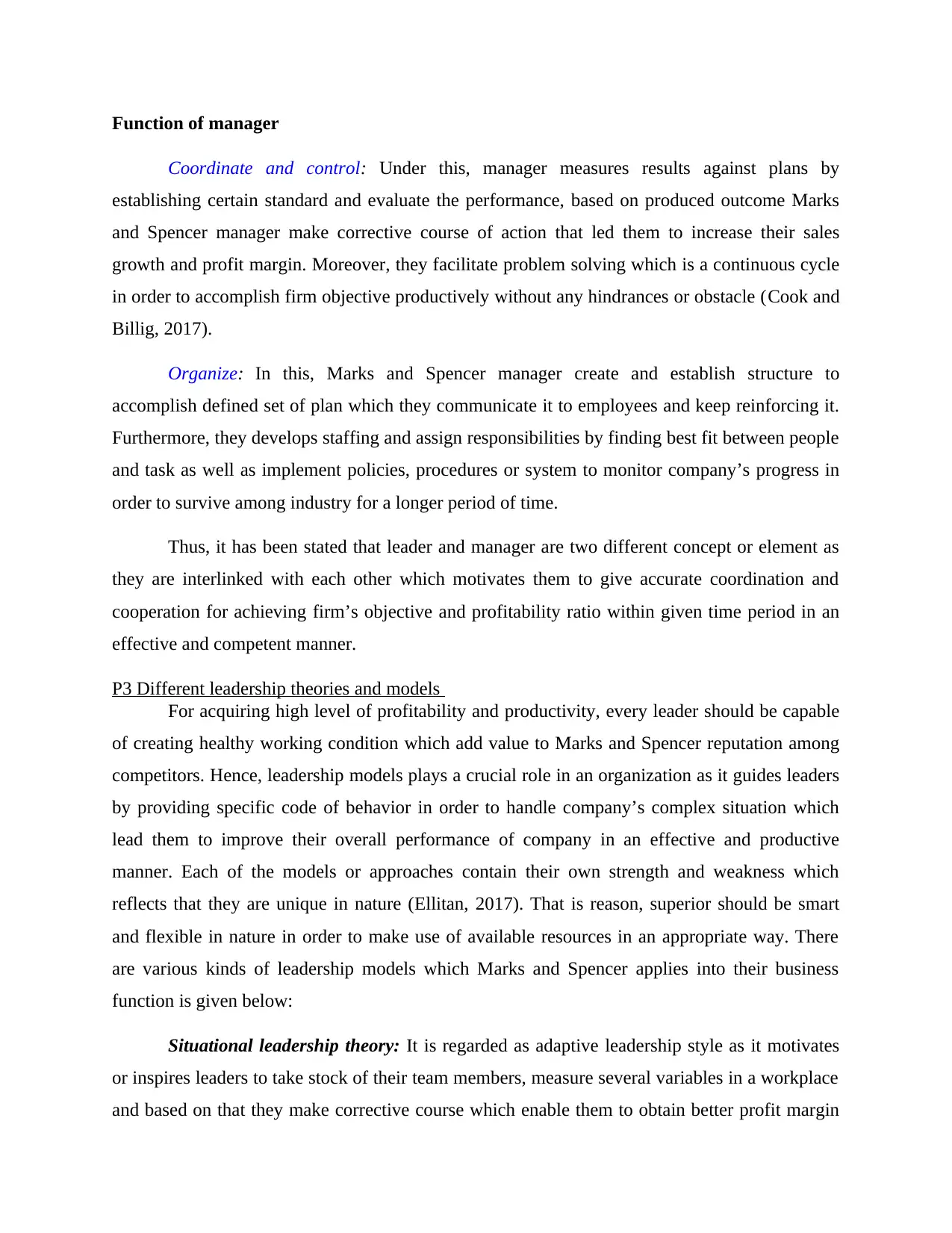
Function of manager
Coordinate and control: Under this, manager measures results against plans by
establishing certain standard and evaluate the performance, based on produced outcome Marks
and Spencer manager make corrective course of action that led them to increase their sales
growth and profit margin. Moreover, they facilitate problem solving which is a continuous cycle
in order to accomplish firm objective productively without any hindrances or obstacle (Cook and
Billig, 2017).
Organize: In this, Marks and Spencer manager create and establish structure to
accomplish defined set of plan which they communicate it to employees and keep reinforcing it.
Furthermore, they develops staffing and assign responsibilities by finding best fit between people
and task as well as implement policies, procedures or system to monitor company’s progress in
order to survive among industry for a longer period of time.
Thus, it has been stated that leader and manager are two different concept or element as
they are interlinked with each other which motivates them to give accurate coordination and
cooperation for achieving firm’s objective and profitability ratio within given time period in an
effective and competent manner.
P3 Different leadership theories and models
For acquiring high level of profitability and productivity, every leader should be capable
of creating healthy working condition which add value to Marks and Spencer reputation among
competitors. Hence, leadership models plays a crucial role in an organization as it guides leaders
by providing specific code of behavior in order to handle company’s complex situation which
lead them to improve their overall performance of company in an effective and productive
manner. Each of the models or approaches contain their own strength and weakness which
reflects that they are unique in nature (Ellitan, 2017). That is reason, superior should be smart
and flexible in nature in order to make use of available resources in an appropriate way. There
are various kinds of leadership models which Marks and Spencer applies into their business
function is given below:
Situational leadership theory: It is regarded as adaptive leadership style as it motivates
or inspires leaders to take stock of their team members, measure several variables in a workplace
and based on that they make corrective course which enable them to obtain better profit margin
Coordinate and control: Under this, manager measures results against plans by
establishing certain standard and evaluate the performance, based on produced outcome Marks
and Spencer manager make corrective course of action that led them to increase their sales
growth and profit margin. Moreover, they facilitate problem solving which is a continuous cycle
in order to accomplish firm objective productively without any hindrances or obstacle (Cook and
Billig, 2017).
Organize: In this, Marks and Spencer manager create and establish structure to
accomplish defined set of plan which they communicate it to employees and keep reinforcing it.
Furthermore, they develops staffing and assign responsibilities by finding best fit between people
and task as well as implement policies, procedures or system to monitor company’s progress in
order to survive among industry for a longer period of time.
Thus, it has been stated that leader and manager are two different concept or element as
they are interlinked with each other which motivates them to give accurate coordination and
cooperation for achieving firm’s objective and profitability ratio within given time period in an
effective and competent manner.
P3 Different leadership theories and models
For acquiring high level of profitability and productivity, every leader should be capable
of creating healthy working condition which add value to Marks and Spencer reputation among
competitors. Hence, leadership models plays a crucial role in an organization as it guides leaders
by providing specific code of behavior in order to handle company’s complex situation which
lead them to improve their overall performance of company in an effective and productive
manner. Each of the models or approaches contain their own strength and weakness which
reflects that they are unique in nature (Ellitan, 2017). That is reason, superior should be smart
and flexible in nature in order to make use of available resources in an appropriate way. There
are various kinds of leadership models which Marks and Spencer applies into their business
function is given below:
Situational leadership theory: It is regarded as adaptive leadership style as it motivates
or inspires leaders to take stock of their team members, measure several variables in a workplace
and based on that they make corrective course which enable them to obtain better profit margin
⊘ This is a preview!⊘
Do you want full access?
Subscribe today to unlock all pages.

Trusted by 1+ million students worldwide
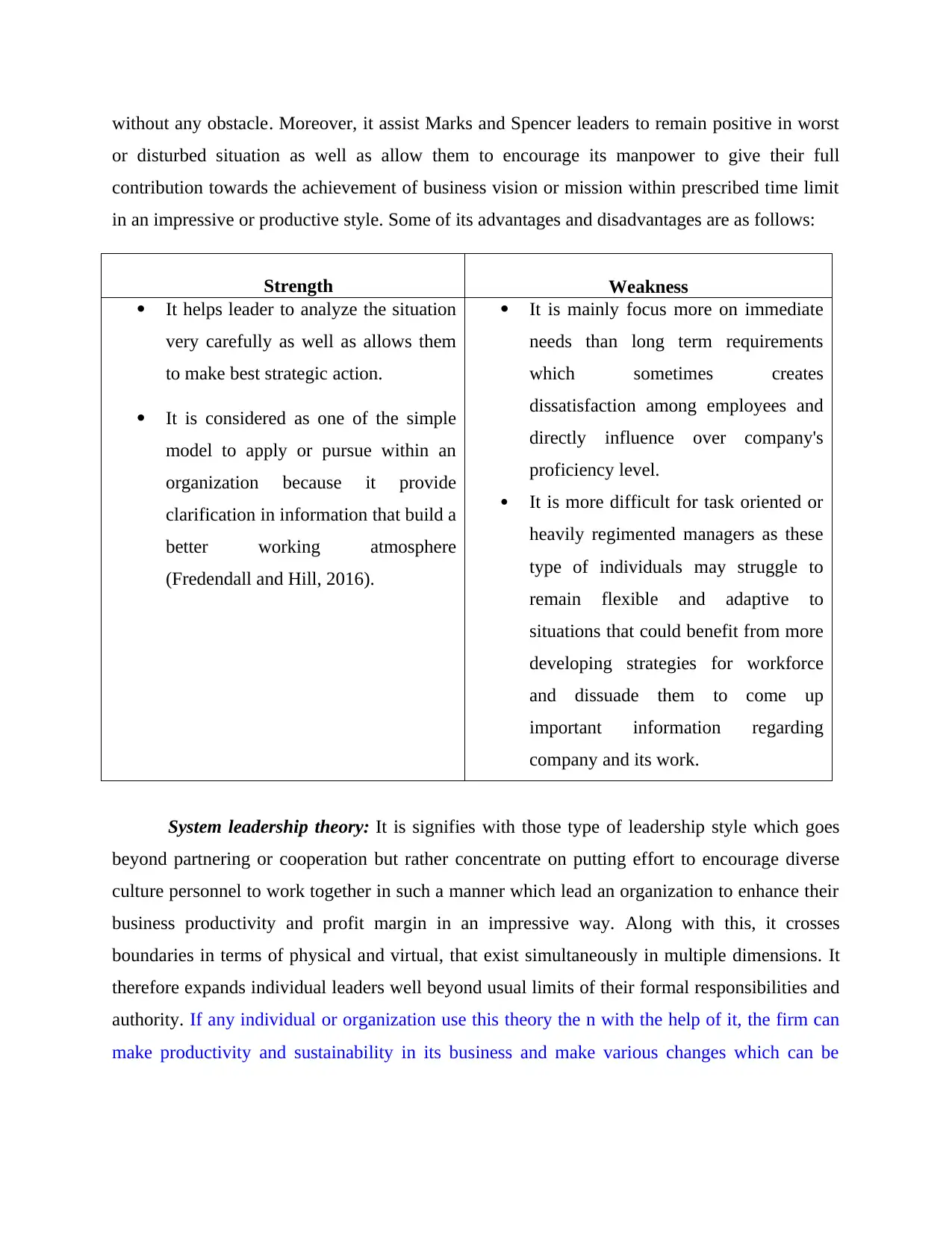
without any obstacle. Moreover, it assist Marks and Spencer leaders to remain positive in worst
or disturbed situation as well as allow them to encourage its manpower to give their full
contribution towards the achievement of business vision or mission within prescribed time limit
in an impressive or productive style. Some of its advantages and disadvantages are as follows:
Strength Weakness
It helps leader to analyze the situation
very carefully as well as allows them
to make best strategic action.
It is considered as one of the simple
model to apply or pursue within an
organization because it provide
clarification in information that build a
better working atmosphere
(Fredendall and Hill, 2016).
It is mainly focus more on immediate
needs than long term requirements
which sometimes creates
dissatisfaction among employees and
directly influence over company's
proficiency level.
It is more difficult for task oriented or
heavily regimented managers as these
type of individuals may struggle to
remain flexible and adaptive to
situations that could benefit from more
developing strategies for workforce
and dissuade them to come up
important information regarding
company and its work.
System leadership theory: It is signifies with those type of leadership style which goes
beyond partnering or cooperation but rather concentrate on putting effort to encourage diverse
culture personnel to work together in such a manner which lead an organization to enhance their
business productivity and profit margin in an impressive way. Along with this, it crosses
boundaries in terms of physical and virtual, that exist simultaneously in multiple dimensions. It
therefore expands individual leaders well beyond usual limits of their formal responsibilities and
authority. If any individual or organization use this theory the n with the help of it, the firm can
make productivity and sustainability in its business and make various changes which can be
or disturbed situation as well as allow them to encourage its manpower to give their full
contribution towards the achievement of business vision or mission within prescribed time limit
in an impressive or productive style. Some of its advantages and disadvantages are as follows:
Strength Weakness
It helps leader to analyze the situation
very carefully as well as allows them
to make best strategic action.
It is considered as one of the simple
model to apply or pursue within an
organization because it provide
clarification in information that build a
better working atmosphere
(Fredendall and Hill, 2016).
It is mainly focus more on immediate
needs than long term requirements
which sometimes creates
dissatisfaction among employees and
directly influence over company's
proficiency level.
It is more difficult for task oriented or
heavily regimented managers as these
type of individuals may struggle to
remain flexible and adaptive to
situations that could benefit from more
developing strategies for workforce
and dissuade them to come up
important information regarding
company and its work.
System leadership theory: It is signifies with those type of leadership style which goes
beyond partnering or cooperation but rather concentrate on putting effort to encourage diverse
culture personnel to work together in such a manner which lead an organization to enhance their
business productivity and profit margin in an impressive way. Along with this, it crosses
boundaries in terms of physical and virtual, that exist simultaneously in multiple dimensions. It
therefore expands individual leaders well beyond usual limits of their formal responsibilities and
authority. If any individual or organization use this theory the n with the help of it, the firm can
make productivity and sustainability in its business and make various changes which can be
Paraphrase This Document
Need a fresh take? Get an instant paraphrase of this document with our AI Paraphraser
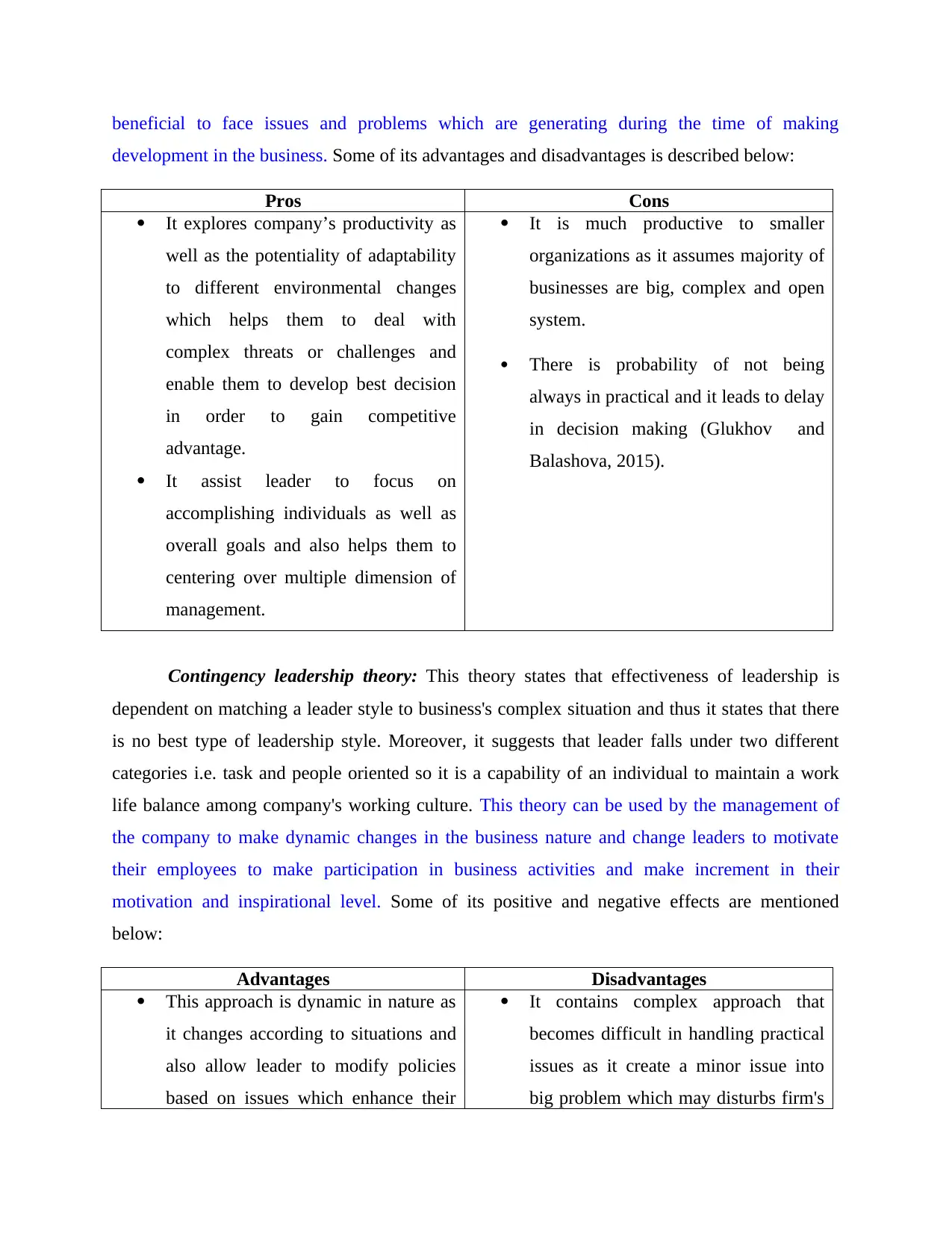
beneficial to face issues and problems which are generating during the time of making
development in the business. Some of its advantages and disadvantages is described below:
Pros Cons
It explores company’s productivity as
well as the potentiality of adaptability
to different environmental changes
which helps them to deal with
complex threats or challenges and
enable them to develop best decision
in order to gain competitive
advantage.
It assist leader to focus on
accomplishing individuals as well as
overall goals and also helps them to
centering over multiple dimension of
management.
It is much productive to smaller
organizations as it assumes majority of
businesses are big, complex and open
system.
There is probability of not being
always in practical and it leads to delay
in decision making (Glukhov and
Balashova, 2015).
Contingency leadership theory: This theory states that effectiveness of leadership is
dependent on matching a leader style to business's complex situation and thus it states that there
is no best type of leadership style. Moreover, it suggests that leader falls under two different
categories i.e. task and people oriented so it is a capability of an individual to maintain a work
life balance among company's working culture. This theory can be used by the management of
the company to make dynamic changes in the business nature and change leaders to motivate
their employees to make participation in business activities and make increment in their
motivation and inspirational level. Some of its positive and negative effects are mentioned
below:
Advantages Disadvantages
This approach is dynamic in nature as
it changes according to situations and
also allow leader to modify policies
based on issues which enhance their
It contains complex approach that
becomes difficult in handling practical
issues as it create a minor issue into
big problem which may disturbs firm's
development in the business. Some of its advantages and disadvantages is described below:
Pros Cons
It explores company’s productivity as
well as the potentiality of adaptability
to different environmental changes
which helps them to deal with
complex threats or challenges and
enable them to develop best decision
in order to gain competitive
advantage.
It assist leader to focus on
accomplishing individuals as well as
overall goals and also helps them to
centering over multiple dimension of
management.
It is much productive to smaller
organizations as it assumes majority of
businesses are big, complex and open
system.
There is probability of not being
always in practical and it leads to delay
in decision making (Glukhov and
Balashova, 2015).
Contingency leadership theory: This theory states that effectiveness of leadership is
dependent on matching a leader style to business's complex situation and thus it states that there
is no best type of leadership style. Moreover, it suggests that leader falls under two different
categories i.e. task and people oriented so it is a capability of an individual to maintain a work
life balance among company's working culture. This theory can be used by the management of
the company to make dynamic changes in the business nature and change leaders to motivate
their employees to make participation in business activities and make increment in their
motivation and inspirational level. Some of its positive and negative effects are mentioned
below:
Advantages Disadvantages
This approach is dynamic in nature as
it changes according to situations and
also allow leader to modify policies
based on issues which enhance their
It contains complex approach that
becomes difficult in handling practical
issues as it create a minor issue into
big problem which may disturbs firm's
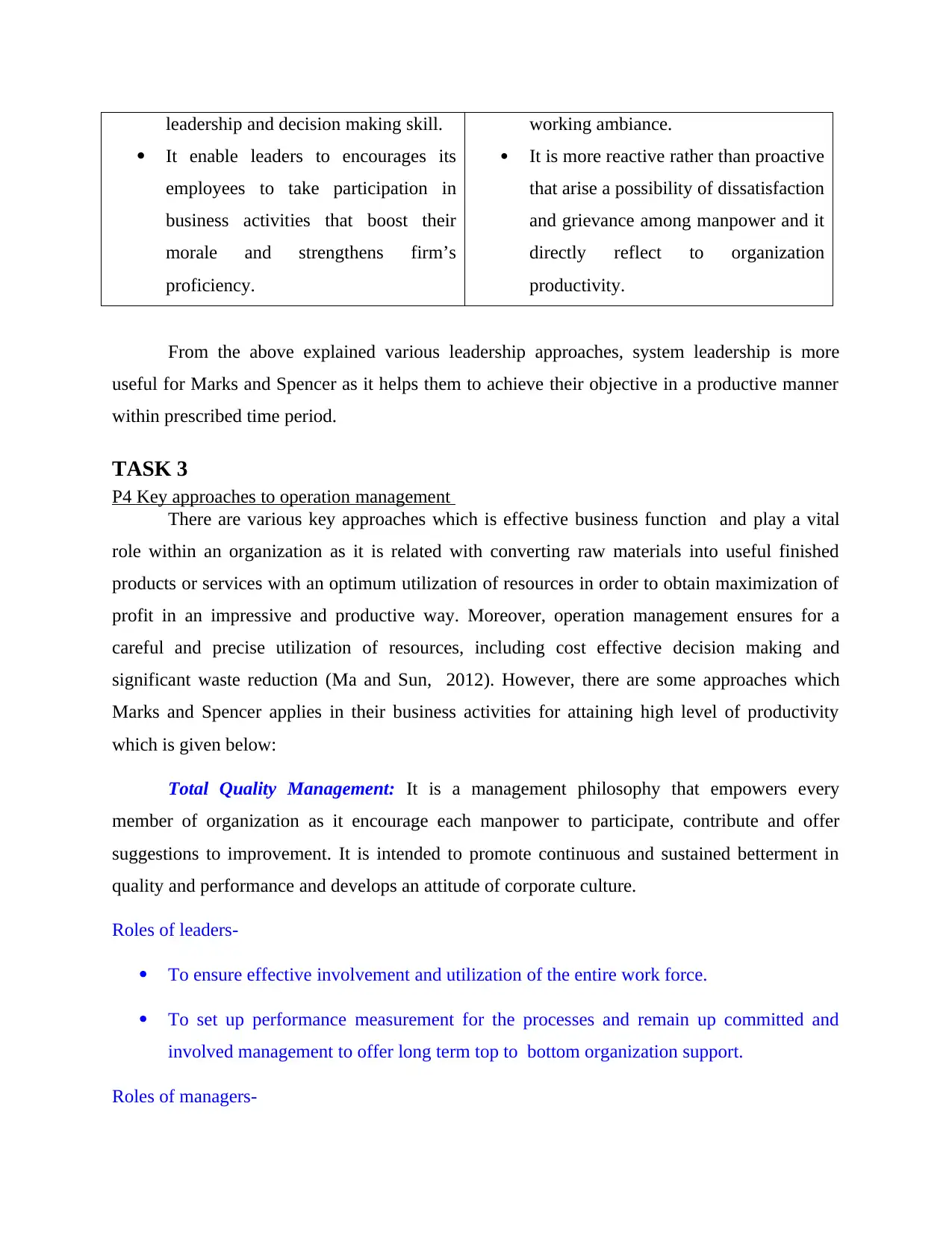
leadership and decision making skill.
It enable leaders to encourages its
employees to take participation in
business activities that boost their
morale and strengthens firm’s
proficiency.
working ambiance.
It is more reactive rather than proactive
that arise a possibility of dissatisfaction
and grievance among manpower and it
directly reflect to organization
productivity.
From the above explained various leadership approaches, system leadership is more
useful for Marks and Spencer as it helps them to achieve their objective in a productive manner
within prescribed time period.
TASK 3
P4 Key approaches to operation management
There are various key approaches which is effective business function and play a vital
role within an organization as it is related with converting raw materials into useful finished
products or services with an optimum utilization of resources in order to obtain maximization of
profit in an impressive and productive way. Moreover, operation management ensures for a
careful and precise utilization of resources, including cost effective decision making and
significant waste reduction (Ma and Sun, 2012). However, there are some approaches which
Marks and Spencer applies in their business activities for attaining high level of productivity
which is given below:
Total Quality Management: It is a management philosophy that empowers every
member of organization as it encourage each manpower to participate, contribute and offer
suggestions to improvement. It is intended to promote continuous and sustained betterment in
quality and performance and develops an attitude of corporate culture.
Roles of leaders-
To ensure effective involvement and utilization of the entire work force.
To set up performance measurement for the processes and remain up committed and
involved management to offer long term top to bottom organization support.
Roles of managers-
It enable leaders to encourages its
employees to take participation in
business activities that boost their
morale and strengthens firm’s
proficiency.
working ambiance.
It is more reactive rather than proactive
that arise a possibility of dissatisfaction
and grievance among manpower and it
directly reflect to organization
productivity.
From the above explained various leadership approaches, system leadership is more
useful for Marks and Spencer as it helps them to achieve their objective in a productive manner
within prescribed time period.
TASK 3
P4 Key approaches to operation management
There are various key approaches which is effective business function and play a vital
role within an organization as it is related with converting raw materials into useful finished
products or services with an optimum utilization of resources in order to obtain maximization of
profit in an impressive and productive way. Moreover, operation management ensures for a
careful and precise utilization of resources, including cost effective decision making and
significant waste reduction (Ma and Sun, 2012). However, there are some approaches which
Marks and Spencer applies in their business activities for attaining high level of productivity
which is given below:
Total Quality Management: It is a management philosophy that empowers every
member of organization as it encourage each manpower to participate, contribute and offer
suggestions to improvement. It is intended to promote continuous and sustained betterment in
quality and performance and develops an attitude of corporate culture.
Roles of leaders-
To ensure effective involvement and utilization of the entire work force.
To set up performance measurement for the processes and remain up committed and
involved management to offer long term top to bottom organization support.
Roles of managers-
⊘ This is a preview!⊘
Do you want full access?
Subscribe today to unlock all pages.

Trusted by 1+ million students worldwide
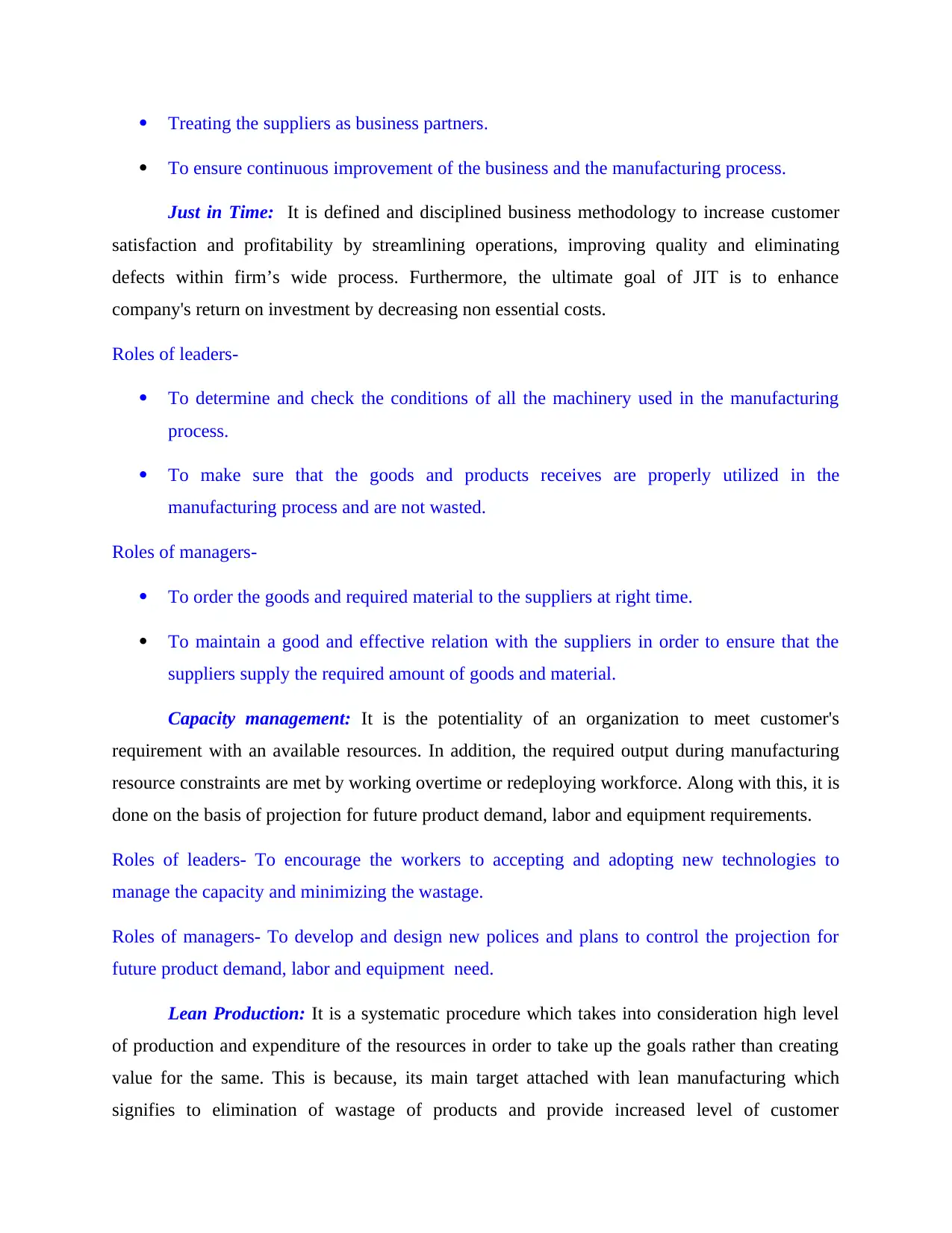
Treating the suppliers as business partners.
To ensure continuous improvement of the business and the manufacturing process.
Just in Time: It is defined and disciplined business methodology to increase customer
satisfaction and profitability by streamlining operations, improving quality and eliminating
defects within firm’s wide process. Furthermore, the ultimate goal of JIT is to enhance
company's return on investment by decreasing non essential costs.
Roles of leaders-
To determine and check the conditions of all the machinery used in the manufacturing
process.
To make sure that the goods and products receives are properly utilized in the
manufacturing process and are not wasted.
Roles of managers-
To order the goods and required material to the suppliers at right time.
To maintain a good and effective relation with the suppliers in order to ensure that the
suppliers supply the required amount of goods and material.
Capacity management: It is the potentiality of an organization to meet customer's
requirement with an available resources. In addition, the required output during manufacturing
resource constraints are met by working overtime or redeploying workforce. Along with this, it is
done on the basis of projection for future product demand, labor and equipment requirements.
Roles of leaders- To encourage the workers to accepting and adopting new technologies to
manage the capacity and minimizing the wastage.
Roles of managers- To develop and design new polices and plans to control the projection for
future product demand, labor and equipment need.
Lean Production: It is a systematic procedure which takes into consideration high level
of production and expenditure of the resources in order to take up the goals rather than creating
value for the same. This is because, its main target attached with lean manufacturing which
signifies to elimination of wastage of products and provide increased level of customer
To ensure continuous improvement of the business and the manufacturing process.
Just in Time: It is defined and disciplined business methodology to increase customer
satisfaction and profitability by streamlining operations, improving quality and eliminating
defects within firm’s wide process. Furthermore, the ultimate goal of JIT is to enhance
company's return on investment by decreasing non essential costs.
Roles of leaders-
To determine and check the conditions of all the machinery used in the manufacturing
process.
To make sure that the goods and products receives are properly utilized in the
manufacturing process and are not wasted.
Roles of managers-
To order the goods and required material to the suppliers at right time.
To maintain a good and effective relation with the suppliers in order to ensure that the
suppliers supply the required amount of goods and material.
Capacity management: It is the potentiality of an organization to meet customer's
requirement with an available resources. In addition, the required output during manufacturing
resource constraints are met by working overtime or redeploying workforce. Along with this, it is
done on the basis of projection for future product demand, labor and equipment requirements.
Roles of leaders- To encourage the workers to accepting and adopting new technologies to
manage the capacity and minimizing the wastage.
Roles of managers- To develop and design new polices and plans to control the projection for
future product demand, labor and equipment need.
Lean Production: It is a systematic procedure which takes into consideration high level
of production and expenditure of the resources in order to take up the goals rather than creating
value for the same. This is because, its main target attached with lean manufacturing which
signifies to elimination of wastage of products and provide increased level of customer
Paraphrase This Document
Need a fresh take? Get an instant paraphrase of this document with our AI Paraphraser
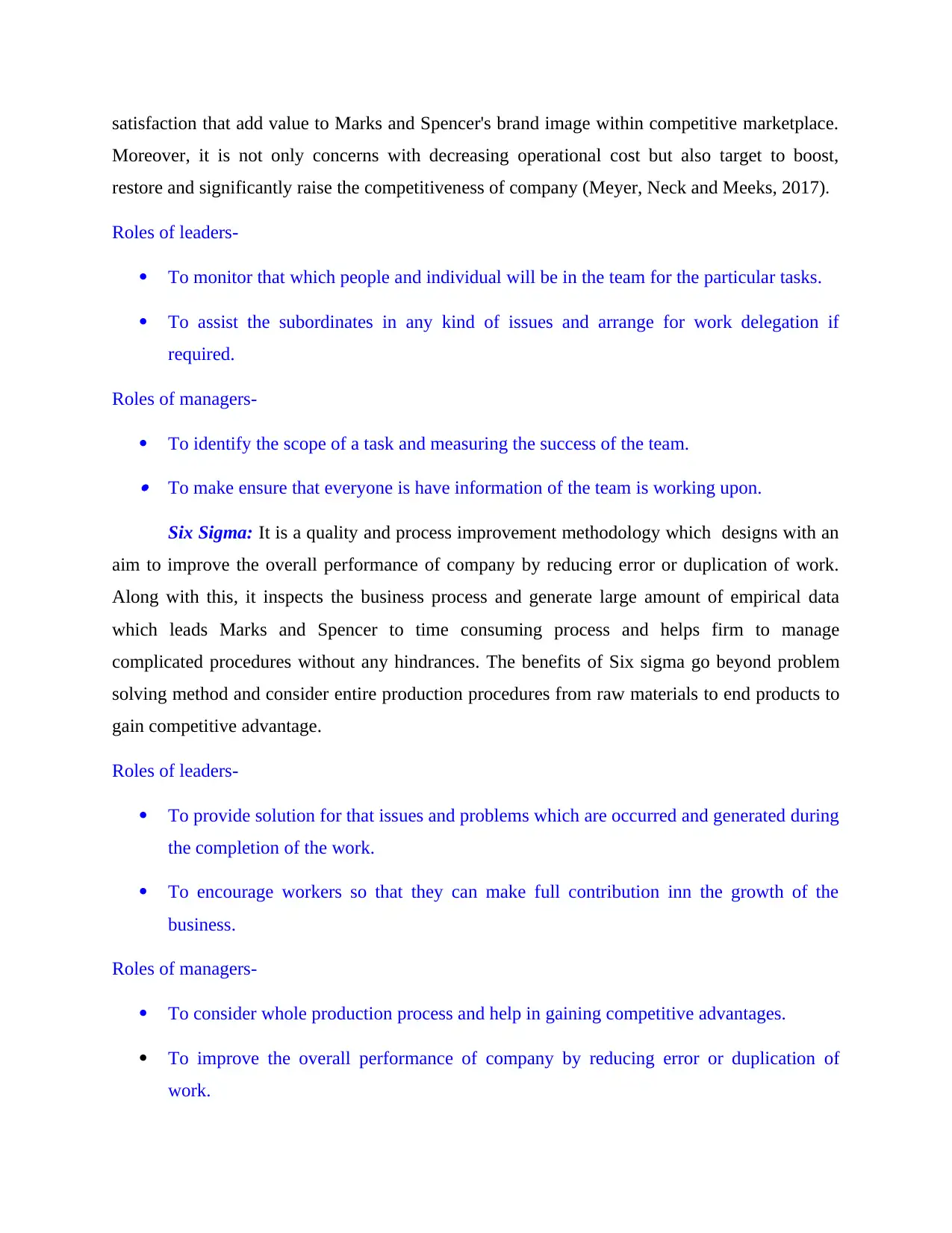
satisfaction that add value to Marks and Spencer's brand image within competitive marketplace.
Moreover, it is not only concerns with decreasing operational cost but also target to boost,
restore and significantly raise the competitiveness of company (Meyer, Neck and Meeks, 2017).
Roles of leaders-
To monitor that which people and individual will be in the team for the particular tasks.
To assist the subordinates in any kind of issues and arrange for work delegation if
required.
Roles of managers-
To identify the scope of a task and measuring the success of the team. To make ensure that everyone is have information of the team is working upon.
Six Sigma: It is a quality and process improvement methodology which designs with an
aim to improve the overall performance of company by reducing error or duplication of work.
Along with this, it inspects the business process and generate large amount of empirical data
which leads Marks and Spencer to time consuming process and helps firm to manage
complicated procedures without any hindrances. The benefits of Six sigma go beyond problem
solving method and consider entire production procedures from raw materials to end products to
gain competitive advantage.
Roles of leaders-
To provide solution for that issues and problems which are occurred and generated during
the completion of the work.
To encourage workers so that they can make full contribution inn the growth of the
business.
Roles of managers-
To consider whole production process and help in gaining competitive advantages.
To improve the overall performance of company by reducing error or duplication of
work.
Moreover, it is not only concerns with decreasing operational cost but also target to boost,
restore and significantly raise the competitiveness of company (Meyer, Neck and Meeks, 2017).
Roles of leaders-
To monitor that which people and individual will be in the team for the particular tasks.
To assist the subordinates in any kind of issues and arrange for work delegation if
required.
Roles of managers-
To identify the scope of a task and measuring the success of the team. To make ensure that everyone is have information of the team is working upon.
Six Sigma: It is a quality and process improvement methodology which designs with an
aim to improve the overall performance of company by reducing error or duplication of work.
Along with this, it inspects the business process and generate large amount of empirical data
which leads Marks and Spencer to time consuming process and helps firm to manage
complicated procedures without any hindrances. The benefits of Six sigma go beyond problem
solving method and consider entire production procedures from raw materials to end products to
gain competitive advantage.
Roles of leaders-
To provide solution for that issues and problems which are occurred and generated during
the completion of the work.
To encourage workers so that they can make full contribution inn the growth of the
business.
Roles of managers-
To consider whole production process and help in gaining competitive advantages.
To improve the overall performance of company by reducing error or duplication of
work.
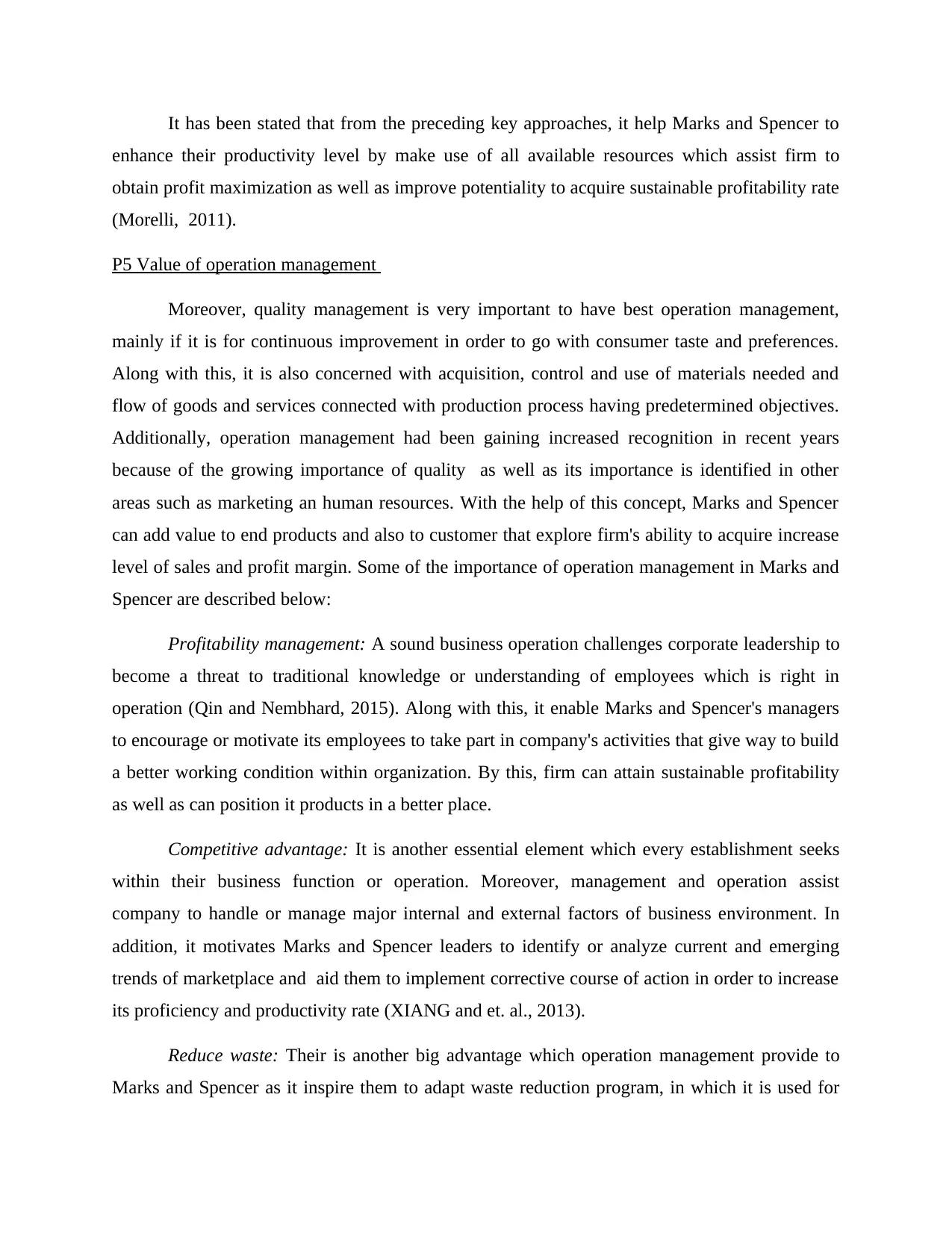
It has been stated that from the preceding key approaches, it help Marks and Spencer to
enhance their productivity level by make use of all available resources which assist firm to
obtain profit maximization as well as improve potentiality to acquire sustainable profitability rate
(Morelli, 2011).
P5 Value of operation management
Moreover, quality management is very important to have best operation management,
mainly if it is for continuous improvement in order to go with consumer taste and preferences.
Along with this, it is also concerned with acquisition, control and use of materials needed and
flow of goods and services connected with production process having predetermined objectives.
Additionally, operation management had been gaining increased recognition in recent years
because of the growing importance of quality as well as its importance is identified in other
areas such as marketing an human resources. With the help of this concept, Marks and Spencer
can add value to end products and also to customer that explore firm's ability to acquire increase
level of sales and profit margin. Some of the importance of operation management in Marks and
Spencer are described below:
Profitability management: A sound business operation challenges corporate leadership to
become a threat to traditional knowledge or understanding of employees which is right in
operation (Qin and Nembhard, 2015). Along with this, it enable Marks and Spencer's managers
to encourage or motivate its employees to take part in company's activities that give way to build
a better working condition within organization. By this, firm can attain sustainable profitability
as well as can position it products in a better place.
Competitive advantage: It is another essential element which every establishment seeks
within their business function or operation. Moreover, management and operation assist
company to handle or manage major internal and external factors of business environment. In
addition, it motivates Marks and Spencer leaders to identify or analyze current and emerging
trends of marketplace and aid them to implement corrective course of action in order to increase
its proficiency and productivity rate (XIANG and et. al., 2013).
Reduce waste: Their is another big advantage which operation management provide to
Marks and Spencer as it inspire them to adapt waste reduction program, in which it is used for
enhance their productivity level by make use of all available resources which assist firm to
obtain profit maximization as well as improve potentiality to acquire sustainable profitability rate
(Morelli, 2011).
P5 Value of operation management
Moreover, quality management is very important to have best operation management,
mainly if it is for continuous improvement in order to go with consumer taste and preferences.
Along with this, it is also concerned with acquisition, control and use of materials needed and
flow of goods and services connected with production process having predetermined objectives.
Additionally, operation management had been gaining increased recognition in recent years
because of the growing importance of quality as well as its importance is identified in other
areas such as marketing an human resources. With the help of this concept, Marks and Spencer
can add value to end products and also to customer that explore firm's ability to acquire increase
level of sales and profit margin. Some of the importance of operation management in Marks and
Spencer are described below:
Profitability management: A sound business operation challenges corporate leadership to
become a threat to traditional knowledge or understanding of employees which is right in
operation (Qin and Nembhard, 2015). Along with this, it enable Marks and Spencer's managers
to encourage or motivate its employees to take part in company's activities that give way to build
a better working condition within organization. By this, firm can attain sustainable profitability
as well as can position it products in a better place.
Competitive advantage: It is another essential element which every establishment seeks
within their business function or operation. Moreover, management and operation assist
company to handle or manage major internal and external factors of business environment. In
addition, it motivates Marks and Spencer leaders to identify or analyze current and emerging
trends of marketplace and aid them to implement corrective course of action in order to increase
its proficiency and productivity rate (XIANG and et. al., 2013).
Reduce waste: Their is another big advantage which operation management provide to
Marks and Spencer as it inspire them to adapt waste reduction program, in which it is used for
⊘ This is a preview!⊘
Do you want full access?
Subscribe today to unlock all pages.

Trusted by 1+ million students worldwide
1 out of 15
Related Documents
Your All-in-One AI-Powered Toolkit for Academic Success.
+13062052269
info@desklib.com
Available 24*7 on WhatsApp / Email
![[object Object]](/_next/static/media/star-bottom.7253800d.svg)
Unlock your academic potential
Copyright © 2020–2025 A2Z Services. All Rights Reserved. Developed and managed by ZUCOL.





